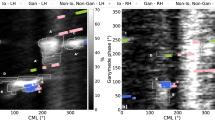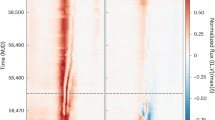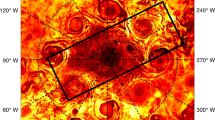Abstract
DURING the period September 1–December 31, 1963, observations of the polarization of radio-wave emission from Jupiter were made at 15.2, 16.2, 18.2, 22.2, and 24.2 Mc/s. The Southwest Research Institute two-helix polarimeter1, utilizing a twin channel receiver, was expanded so that determination of the cross-correlation of the right and left circular components, in addition to the two opposite circular components, was made separately for each Jupiter burst. This type of radio polarimeter scheme has been described by Cohen2. The calibrated polarimeter thus provided determination of the polarization fraction (m), axial ratio (r) and sense of the Jupiter bursts observed.
This is a preview of subscription content, access via your institution
Access options
Subscribe to this journal
Receive 51 print issues and online access
$199.00 per year
only $3.90 per issue
Buy this article
- Purchase on SpringerLink
- Instant access to full article PDF
Prices may be subject to local taxes which are calculated during checkout
Similar content being viewed by others
References
Sherrill, W. M., and Castles, M. P., Astrophys., J., 138, 587 (1963).
Cohen, M. H., Proc. Inst. Rad. Eng., 46, 172 (1958).
Ellis, G. R. A., and McCulloch, P. M., Austral. J. Phys., 16, 380 (1963).
Dowden, R. L., Austral. J. Phys., 16, 398 (1963).
Carr, T. D., et al., Astrophys. J., 134, 105 (1961).
Author information
Authors and Affiliations
Rights and permissions
About this article
Cite this article
SHERRILL, W. Polarization of Jovian Emission at Decametre Wave-lengths. Nature 205, 270–271 (1965). https://doi.org/10.1038/205270a0
Issue date:
DOI: https://doi.org/10.1038/205270a0
This article is cited by
-
Enhanced expression of alkaline phosphatase in hybrids between neuroblastoma and embryonal carcinoma
Somatic Cell Genetics (1977)



